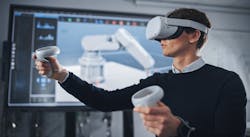Immersive virtual reality (VR) has emerged as a powerful tool for training new employees and refreshing the skills of current staff. VR can create realistic simulations, offer engaging learning experiences, and facilitate remote training. It provides a safe, immersive, and cost-effective environment to help employees practice and learn complex processes to prepare them for the manufacturing floor. VR technology enables self-led and remote learning, making education accessible to anyone, anywhere in the world.
There are numerous advantages of VR training in manufacturing, ranging from increased knowledge retention and confidence, to equipping operators with a broader range of skills, leading to better performance and productivity.
No instrument needed
VR technology can create realistic simulations of complex processes while minimizing the downtime of production lines and optimizing overall productivity. Historically, training employees required shutting down existing production lines or slowing down operations, whilst using skilled operators to provide the training, further reducing overall productivity. VR training eliminates the need for such disruptions, as training can occur independently and parallel to regular production. It is important to note that VR is not currently positioned to replace face-to-face training, or existing final-sign off by training managers, but to boost trainees’ overall knowledge of systems or processes for faster sign-off.
With immersive virtual reality training solutions, you’ll see a boost in productivity and a decrease in training time due to a more captivating and interactive learning journey allowing people to master new skills more efficiently. Furthermore, they can revisit any step as often as needed without starting over, reducing the repetition of unnecessary re-training, and further boosting training satisfaction and time-to-competency.
Immersive learning
When learning a new skill, one key challenge is retaining this new information to be used later. Remembering what you learned can often require multiple reads of a handbook or a few tries at working ‘toggles and handles’ but learning step-by-step by doing is more effective and time efficient.
Active participation is an essential part of any learning process. Instead of passively observing or reading instructions, trainees actively engage with the virtual environment, perform tasks, and make decisions. Some of the benefits of this include receiving sensory inputs that closely mimic real-life experiences, internalizing the processes, and building muscle memory in an environment where no risk to expensive equipment or consumables can happen, thus also reducing the anxiety that often takes place when learning on physical instrumentation. The ability to revisit specific steps or procedures strengthens the neural connections associated with that cognitive processing, leading to better retention in less time.
Accessible anytime, anywhere
The global pandemic enlightened us on many things, but one major learning was that not everything needs to be face-to-face.
When it comes to training, waiting to train in a face-to-face setting can slow manufacturing lines as trainees wait to understand new equipment. Training within the virtual environment eliminates this time constraint and allows training to take place out of manufacturing spaces and instead use meeting rooms or social spaces. Without the restrictions of manufacturing cycles, access to equipment, or subject matter expert availability, trainees can train at any time, even if working remotely.
Multiple trainees can join a shared space and explore training together irrespective of location globally. This type of learning environment fosters collaboration, and enjoyment, during a traditionally very formal exercise. This in turn leads to increased overall satisfaction with content delivery.
Tailored training for effectiveness
One of the key strengths of VR technology is its ability to personalize training to meet individual needs, styles, skills, and pace. By catering to individual strengths and weaknesses, VR training maximizes the transfer of knowledge, leading to better overall performance and employee satisfaction.
Customized learning can be of particular use for those wishing to refresh their skills. This plays an essential role in boosting confidence, as it ensures that operators are neither overwhelmed by tasks that are too difficult nor bored by tasks that are too easy. By adapting to the trainee's pace, the learning process is neither rushed nor prolonged, optimizing understanding and retention of the material.
Targeted instruction, additional resources, or simple exercises help trainees overcome their challenges, potentially leading to them feeling more valued and motivated. This personalized attention and support can also contribute to more effective learning and skill development.
VR training is important for individual growth and development, it enhances trainees' engagement and enthusiasm for the training process when compared to the traditional methods of delivery. This increased motivation translates into improved focus, effort, and participation, leading to better learning outcomes.
Cost-effectiveness
Cost control is essential in every sector, but especially so in biomanufacturing where access to lifesaving therapies can be restricted by costly processes. By granting access to equipment training to all operators, costs and time normally associated with training can be significantly reduced. Not only will VR reduce the consumable costs associated with hands-on training, but it will reduce the equipment downtime required.
Specifically, if more operators are now trained to a higher level using VR, more advanced training can be delivered using the same allocated training time. Concepts that are nuanced or site-specific are far easier to learn when everyone in the training group is already aware of the system and its basic operations.
In an age where equipment manufacturers are increasingly offering end-to-end rapid deployment of manufacturing lines, or even entire facilities, access to trained operators is going to offer manufacturers an opportunity to differentiate themselves. As the world looks to localize manufacturing capabilities, further compounding roadblocks to speedy deployment, tools like virtual reality are necessary to turn this into a living reality.
